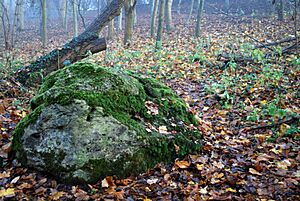St. Edmund's Chapel, Lyng facts for kids
Quick facts for kids St. Edmund's Chapel |
|
|---|---|

The fragmentary ruins of the chapel
|
|
| Religion | |
| Affiliation | Christianity |
| Status | Ruin |
| Location | |
| Location | Lyng, Norfolk |
| Country | UK |
St. Edmund's Chapel is an old ruined building in a field near the village of Lyng in Norfolk, England. It was once a very important religious place. There was also another religious building in Lyng called St. Margaret's Church.
This chapel was part of a nunnery, which was a home for nuns who followed the Benedictine way of life. People believed it was built to remember a big battle. This battle was fought against the Danes in the 800s. It was a time when King Edmund died.
Contents
Chapel History: From Nuns to Ruins
The nuns moved from Lyng to Thetford in 1176. But the chapel in Lyng was still used until at least 1250. Even in 1287, the head nun from St. George's Priory, Thetford held a fair at the chapel site. The nuns kept some land and a house in Lyng. They used the money from this land to pay a chaplain to look after the chapel.
In 1438, there was a legal disagreement between the head nun and the church leader of Lyng. After this, the land was given to the village church.
Miracles at the Chapel
An old book from the 1370s mentions the chapel. It says that over five years, seven amazing things, or "miracles," happened there. Most of these events took place in nearby villages like Bylaugh, Scarning, and Sparham. One story tells of a man from Kent whose wife was cured of her paralysis at the chapel.
The Chapel Becomes a Ruin
By 1730, the chapel was already in ruins. The brickwork you can still see today was likely built in the 1400s. It's possible the chapel was used until the time of the Reformation. This was a period in the 1500s when big changes happened in the church. It might have been a "chapel of ease" for the small area of Lyng Eastaugh.
Today, the ruins are very broken up. A famous expert named Nikolaus Pevsner saw a surviving arch in the 1950s. This might have been the north doorway. Now, only a small part of that arch remains. Plants and trees mostly cover the ruins. People have found many old objects at the site. These objects date from Roman times all the way to after the Middle Ages. In the 1800s, human skeletons were found between the chapel and the road.
Folklore and the Great Stone of Lyng
A newspaper article from 1939 shared an old story about the chapel. It was said that the nuns built it to pray for the people who died in a battle. This battle was between the Danes and King Edmund's Anglo-Saxons. It might have happened close to where the chapel stands.
South of the chapel is a wooded area called The Grove. On old maps from the 1700s, it was called King's Grove. An "ancient" path, called a hollow way, goes through this wood. It connects a small area called Collen's Green to the main road.
The Great Stone of Lyng
Next to this path is a huge rock known as the Great Stone of Lyng. It's a very large stone that was left behind by a melting glacier. It's about 2 meters long and 1 meter wide. Many old stories are connected to this stone. People have linked it to ancient priests called druids, to devils, and to strange sounds. Some even believed the stone could move or grow! There are also tales of burials and hidden treasure near it. One old belief was that the stone would bleed if you pricked it with a pin.
The Annual Fair
When the nuns left Lyng in the 1100s, they still earned money from holding a yearly fair. This fair took place on November 20th, which is St. Edmund's Day. This fair continued for a very long time, even after the nunnery was gone. It was still happening in the late 1800s. Parson Woodforde even wrote about it in his diary. There was also a special group in the village called the Guild of St. Edmund.


